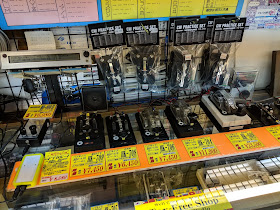I walked but there is a station at the heart of the place. (Click photos to enlarge them by the way)/.
There are literal department stores full of independent electronics shops. Some are multi-story.
Inside you'll find all the components you could desire plus boxes and boards.
There's a well stocked valve store.
There's some interesting home kit gear on show too. Here's a crystal set with a spider coil.
A 40m SSB transceiver I haven't heard of before.
Lots and lots of shops selling commercial gear with VHF/UHF handhelds in huge quantities.
All the big black boxes are on show and I notice, looking at the FT-817 price index, that prices vary significantly.
A big store, Rocket Radio, also has a good collection of antenna parts. Interestingly they have a surprising number of loop antennas available.
Great to see that they are well stocked with morse keys.
Not a lot of English is spoken and unfortunately the shop keepers seem rather embarrassed about this. I did a bit of pointing and tried to be friendly.
Anyhow, I'm very lucky to be here this week. If you do get to Tokyo don't forget to check it out.

































